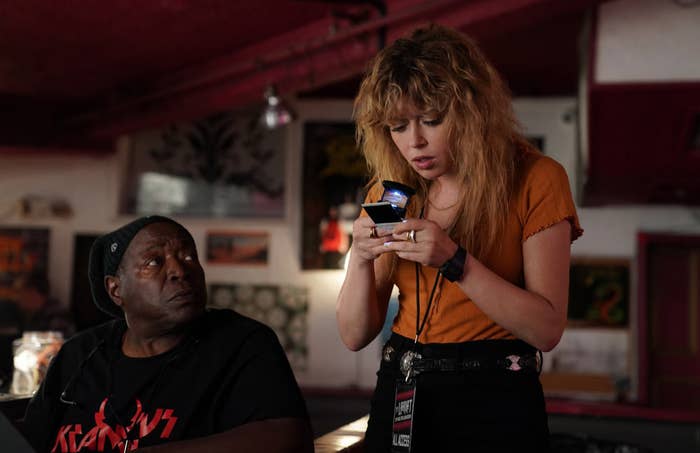
With 2019’s Knives Out and 2022’s Glass Onion, director Rian Johnson has made a name for himself as Hollywood’s favorite mystery filmmaker. His two famous features revel in big personalities and big costumes, pinwheeling through star-studded ensembles of maladjusted rich people. Now, he’s taking his love of the genre to TV.
Poker Face, the 10-episode Peacock series starring Natasha Lyonne and created by Johnson, premieres tomorrow. It’s a case-of-the-week show in which Lyonne plays Charlie Cale, an ex–casino worker on the run from her vengeful boss. Charlie has the convenient — but remarkably well-justified — gift of knowing exactly when she’s being lied to. So as she flees across the American West, stumbling into a series of unrelated murder cases, she finds herself sniffing out lies and cracking cases almost by accident.
The setting of Poker Face is far less grandiose than Knives Out’s estate or Glass Onion’s private island. Instead, the show delights in the country’s nooks and crannies: dusty strips of highway, dive bars, and back alleys. Its featured players are washed-up artists and whiskey-swigging stagehands, not authors and inventors with copyright empires to their names. It’s a lovely stylistic shift for Johnson, who displays a heartfelt love for road trip cinema with his wide-open shots of the Nevada desert and New Mexico sky. And it’s the perfect home for Lyonne, who excels as the perpetual outsider, the cheeky, charming stranger who can’t help but befriend the underdogs. In each case Charlie ends up solving, she does so out of loyalty to either the victim or the person framed for their death. And though she positions herself as a hardheaded, wisecracking loner with an allergy to bullshit, she bears an underlying tenderness that makes each new friendship of hers compelling, even when the episodes start to feel formulaic.
The show builds tension most effectively when it intertwines its season-long runaway arc with its episodic mysteries. In the season’s standout second episode, Johnson strikes this balance well with a simple storytelling tool. When Charlie uses an ATM, she sets a four-hour countdown on her watch, giving herself a strict deadline to get out of town before her old boss’s head security guard shows up. As she works to solve the episode’s mystery, she keeps checking her watch, squirming each time she wonders if she should stay to prove her new friend’s innocence or leave to save herself. It makes every clue feel more precious and every setback more nail-biting.
Later episodes ditch this urgency entirely, instead making Charlie’s life in hiding feel more like a carefree romp. In these episodes, the show derives its entertainment less from the suspense of mystery-solving and more from the shiny thrill of building new worlds with weird characters. The most successful iterations of this work because of the potent chemistry of guest actors. In an episode where Charlie joins a middle-aged metal band on its reunion tour, Chloë Sevigny’s steely lead singer Ruby Ruin finds an unlikely rival in Gavin, the grubby young drummer she picked up off of Craigslist, played by an effervescent Nicholas Cirillo. They clash again and again: Ruby in head-to-toe black latex performing alongside Gavin in a sweaty tank top, Ruby telling Gavin to shut up while he shrieks about his adoration for her music. The delights of their dynamic make it easy to forgive the parts of the episode that feel crammed in, as in the blink-and-you-miss-it montage where the killers lay their trap, or in the abrupt revelation, mid-episode, that Charlie had been accompanying the band the whole time, just out of frame.
But the least successful versions of this kind of episode — more vibes, less plot — recycle tropes that Johnson already relied upon earlier in the season. For example, one lackluster story, set at a local theater, centers on an aging actor staging a comeback. Though Ellen Barkin acts her heart out, the desperate diva she plays feels like a more clichéd version of the bitter hardcore punk we saw in Sevigny two episodes before.
As a genre, the murder mystery is particularly accommodating of tropes and formulas. It’s a highly stylized kind of storytelling that often depends on elaborate plot pivots and spectacularly shady characters. It’s often fun to witness Johnson’s favorite patterns come back to play in Poker Face. Adrien Brody offers a slimier spin on the idiot billionaire archetype played by Edward Norton in Glass Onion. Charlie’s ability to detect lies is equally useful and far less somber when compared to Marta’s (Ana de Armas) inability to lie in Knives Out. But seeing Johnson’s storytelling instincts iterated again and again over several hourlong episodes makes the weak points stick out, and the predictability of each self-contained story wearisome.
This predictability is somewhat intentional, in that it’s built into the specific setup Johnson uses. He skips the classic Sherlock Holmes premise in which readers or viewers arrive at the scene alongside the detective and have to piece the clues together after the fact. Instead, each episode gives the game away within the first 15 minutes. Viewers bear witness to the exact circumstances of the murder, including who did it and how. In four of the six episodes made available to critics, viewers also immediately find out the killers’ motives. The killers always frame someone else or make it look like an accident, so Charlie has to piece together the truth from lies she overhears. But because viewers know the truth from the beginning, the back halves of these episodes can feel like waiting for Charlie to catch up. By the time she gets around to confronting the killers in a long-winded monologue, it’s hard to blame a viewer for being ready to move on. ●
